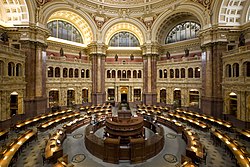| Library of Congress | |
|---|---|
 | |
 Main reading room of the Library's Thomas Jefferson Building | |
| 38°53′19″N 77°0′17″W / 38.88861°N 77.00472°W | |
| Location | Washington, D.C. |
| Established | April 24, 1800 |
| Collection | |
| Size | 173 million items[a] |
| Access and use | |
| Circulation | Onsite use only |
| Population served | Congress, citizens, and international visitors |
| Other information | |
| Budget | $802.128 million[2] |
| Director | Carla Hayden |
| Employees | 3,105[2] |
| Website | loc |
The Library of Congress (LOC) is a research library in Washington, D.C. that serves as the library and research service of the U.S. Congress and the de facto national library of the United States.[3] It also administers copyright law through the United States Copyright Office.
Founded in 1800, the Library of Congress is the oldest federal cultural institution in the U.S.[4] It is housed in three elaborate buildings on Capitol Hill, with a conservation center in Culpeper, Virginia and offsite storage facilities at Fort Meade and Cabin Branch in Maryland.[5] The library's functions are overseen by the Librarian of Congress, and its buildings are maintained by the Architect of the Capitol. The LOC is one of the largest libraries in the world,[3][6] containing approximately 173 million items and employing over 3,000 staff. Its collections are "universal, not limited by subject, format, or national boundary, and include research materials from all parts of the world and in more than 470 languages".[4]
Congress moved to Washington, D.C. in 1800 after holding sessions for eleven years in the temporary national capitals of New York City and Philadelphia, where members of Congress had access to the sizable collections of the New York Society Library and the Library Company of Philadelphia.[7] Pursuant to the act of Congress that established Washington as the new national capital, a small congressional library was housed in the United States Capitol. Much of the library's original collection was burned by British forces during the War of 1812. Congress then accepted Thomas Jefferson's offer to sell his entire personal collection of 6,487 books to restore the library. Over the next few years, the collection slowly grew; in 1851, another fire broke out in the Capitol chambers, which destroyed a large amount of the collection, including two-thirds of Jefferson's books.
The Library of Congress was plagued by space shortages, understaffing, and lack of funding until after the American Civil War, when the importance of legislative research increased to meet the demands of a growing federal government.[8] In 1870, the library was granted the right to receive two copies of every book, map, illustration, and other copyrightable work printed in the United States; it also built its collections through acquisitions and donations. Between 1888 and 1894, Congress constructed and moved the collection to a large adjacent library building, now known as the Thomas Jefferson Building, across the street from the Capitol. Two more adjacent library buildings—the John Adams Building, built in the 1930s, and the James Madison Memorial Building, built in the 1970s—hold expanded parts of the collection and provide space for additional library services.
The LOC maintains its primary mission of informing legislation through researching inquiries made by members of Congress, which is carried out through the Congressional Research Service. The library is open to the public for research, although only members of Congress, Congressional staff, and library employees may borrow books and materials for use outside of the library.[9]
- ^ "Year 2020 at a Glance". Library of Congress. 2020. Archived from the original on February 23, 2021. Retrieved November 5, 2021.
- ^ a b "2021 Annual Report of the Librarian of Congress" (PDF). Library of Congress. Archived (PDF) from the original on February 3, 2023. Retrieved December 2, 2022.
- ^ a b "Library of Congress". Encyclopædia Britannica. Archived from the original on April 5, 2020. Retrieved September 3, 2017.
- ^ a b "Fascinating Facts". Library of Congress. Archived from the original on April 5, 2020. Retrieved April 25, 2018.
- ^ "General Information". Library of Congress. Archived from the original on February 23, 2021. Retrieved January 28, 2023.
- ^ "Fascinating Facts – Statistics". Library of Congress. Archived from the original on April 5, 2020. Retrieved February 16, 2017.
- ^ "History of the Library of Congress". Library of Congress. Archived from the original on October 6, 2020. Retrieved October 20, 2020.
- ^ "The Library of Congress: A Timeline | History of the Library of Congress | About the Library | Library of Congress". Library of Congress, Washington, D.C. 20540 USA. Retrieved September 4, 2024.
- ^ "FY 2019–2023 Strategic Plan of the Library of Congress". Library of Congress. Retrieved October 20, 2020.
Cite error: There are <ref group=lower-alpha> tags or {{efn}} templates on this page, but the references will not show without a {{reflist|group=lower-alpha}} template or {{notelist}} template (see the help page).